Simulation and Optimization of 420 nm InGaNGaN Laser Diodes
冶金工程专业英语词汇
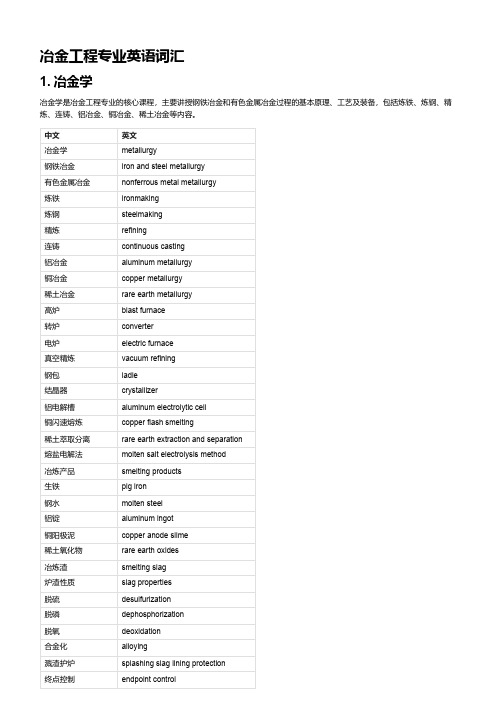
冶金工程专业英语词汇1. 冶金学冶金学是冶金工程专业的核心课程,主要讲授钢铁冶金和有色金属冶金过程的基本原理、工艺及装备,包括炼铁、炼钢、精炼、连铸、铝冶金、铜冶金、稀土冶金等内容。
中文英文冶金学metallurgy钢铁冶金iron and steel metallurgy有色金属冶金nonferrous metal metallurgy炼铁ironmaking炼钢steelmaking精炼refining连铸continuous casting铝冶金aluminum metallurgy铜冶金copper metallurgy稀土冶金rare earth metallurgy高炉blast furnace转炉converter电炉electric furnace真空精炼vacuum refining钢包ladle结晶器crystallizer铝电解槽aluminum electrolytic cell铜闪速熔炼copper flash smelting稀土萃取分离rare earth extraction and separation熔盐电解法molten salt electrolysis method冶炼产品smelting products生铁pig iron钢水molten steel铝锭aluminum ingot铜阳极泥copper anode slime稀土氧化物rare earth oxides冶炼渣smelting slag炉渣性质slag properties脱硫desulfurization脱磷dephosphorization脱氧deoxidation合金化alloying溅渣护炉splashing slag lining protection终点控制endpoint control中文英文出钢操作tapping operation凝固传热机制solidification heat transfer mechanism凝固结构与缺陷solidification structure and defects氧化还原反应oxidation-reduction reaction造渣反应与造渣制度slagging reaction and slagging system2. 冶金物理化学冶金物理化学是冶金工程专业的基础理论课程,主要讲授冶金过程中涉及的物理化学原理和方法,包括平衡与相图、溶液理论、电化学、表面与胶体化学、传递现象等内容。
制造业生产流水线仿真与优化
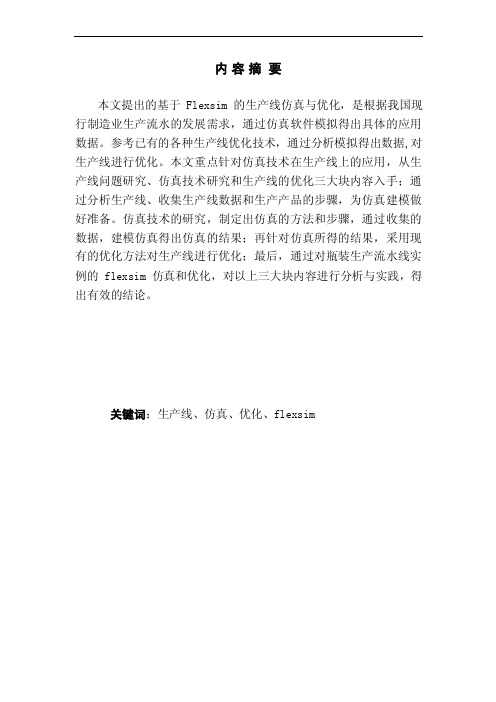
内容摘要本文提出的基于Flexsim的生产线仿真与优化,是根据我国现行制造业生产流水的发展需求,通过仿真软件模拟得出具体的应用数据。
参考已有的各种生产线优化技术,通过分析模拟得出数据,对生产线进行优化。
本文重点针对仿真技术在生产线上的应用,从生产线问题研究、仿真技术研究和生产线的优化三大块内容入手;通过分析生产线、收集生产线数据和生产产品的步骤,为仿真建模做好准备。
仿真技术的研究,制定出仿真的方法和步骤,通过收集的数据,建模仿真得出仿真的结果;再针对仿真所得的结果,采用现有的优化方法对生产线进行优化;最后,通过对瓶装生产流水线实例的flexsim仿真和优化,对以上三大块内容进行分析与实践,得出有效的结论。
关键词:生产线、仿真、优化、flexsimABSTRACTThis paper put forward by Flexsim based on simulation and optimization of the production line, according to existing manufacturing production lines in China's development needs, through the simulation of the simulation software that specific application data. And refer to a variety of existing technologies to optimize production line, through the analysis of simulated data to optimize production lines. This chapter focusing on technology in the production line, from the production line of study, simulation technology research and production lines to optimize,start with these three big parts. Analysis production lines to prepare for simulation modeling, data collection and production of production line products step. According to existing simulation technology, work out the steps of the simulation, through the modeling and simulation data simulation results obtained. Based on the simulation results obtained ,using the existing optimization methods to optimize production lines. Finally,through the case about simulation and optimization of production bottle line, the above analysis of three large pieces of content and practice, to draw valid conclusions.KEYWORDS:Production Line,Simulation, Optimization, FlexsimII目录第一章引言 (1)第一节研究的背景与现状 (1)第二节选题的意义 (1)第二章生产线问题研究 (2)第一节生产线的概念 (2)第二节生产线的生产能力指标 (2)第三节生产线的生产能力的计算与确定 (3)一、单台设备及流水线生产能力的计算和确定 (3)二、设备组生产能力的计算 (3)三、工段(车间)生产能力的计算和确定 (3)第三章离散事件仿真研究 (4)第一节离散事件的概念及要素 (4)第二节离散事件的仿真步骤 (5)第三节 F LEXSIM仿真软件介绍 (7)一、flexsim简介 (7)二、flexsim的功能特点 (8)第四章生产线平衡优化研究 (9)第一节生产线平衡优化的相关概念 (9)第二节生产线平义衡优化的意义 (10)第三节生产线平衡优化的方法 (11)第五章基于FLEXSIM的瓶装生产流水线仿真与优化 (13)第一节基于FLEXSIM对生产线仿真优化的步骤 (13)第二节瓶装生产流水线仿真优化 (14)一、瓶装生产线仿真问题描述 (14)二、瓶装生产线资料的收集与分析 (14)三、瓶装生产线仿真模型的建立 (15)四、装生产线仿真模型的运行与数据分析 (16)五、瓶装生产线仿真模型的优化与再运行 (18)六、瓶装生产线优化后仿真结果分析 (20)第六章结论 (22)中国最大的论文知识平台参考文献 (23)致谢............................... 错误!未定义书签。
轮毂挤压铸造数值模拟与参数优化

C A M E O 凯模C A E 案例库w w w .c a m e o .o r g .c n《热加工工艺》2013年3月第42卷第5期轮毂属于汽车的受力件,承受着汽车的全部质量。
在汽车高速运行过程中,面临着地面的摩擦、碰撞,要求有很好的强度、抗撞击能力;同时,在运行过程中,一直暴露在露天,饱受风吹雨淋,要求有一定的气密性。
总之,服役环境复杂,对其力学性能等都有很高的要求,由此选择铸造成型方法就成了关键。
1轮毂成型工艺试验方法轮毂挤压铸造成型所涉及的工艺参数很多,而每个工艺参数又有多种选择情况,工艺参数组合不同,所铸造出来的轮毂质量也不相同,如果对每种工艺参数组合都做一次试验,则试验次数繁多,甚至试验无法完成。
本文采用正交试验设计法对参数进行试验安排,通过少量试验次数,得出所需要的数据[1]。
正交试验设计,是利用规格化的正交表,恰当的设计出试验方案和有效的分析试验结果,提出最优配方和工艺条件,并进而设计出可能更优秀的试验方案的一种科学方法。
正交表则是利用“均衡搭配”与“整齐可比”这两条基本原理,从大量的全面试验中,为挑选出少量具有代表性的试验点,所制成的排列整齐的规格化表格[2]。
2轮毂成型工艺参数方案的确立挤压铸造不同于其他铸造方式之处是液态合金一直处于压力下直至凝固结束,相对于普通压铸而言,多了一个压力下补缩的过程,挤压压力是其最显著的一个工艺参数,针对38mm 铝合金汽车轮毂,已有较为成熟的挤压力取值为110MPa 。
由于在相同铸造工艺下,镁合金的压力通道阻力比铝合金要大,对于相近形状与体积铸件来说,镁合金应采用比铝合金略高的挤压力[3]。
根据轮毂“挤压压铸”的工艺特性,模具温度和合金液温度对铸件的充型和凝固过程有较大的影响。
初始加压时间以合金液充型完成开始,通过Anycasting 软件自动计算铸件体积与内浇口充型速度的比值得到,与保压时间设定为软件凝固过程模拟结束时自动结束。
3试验过程及结果分析本文针对挤压压力,合金液浇注温度,模具初始温度3个参数,选取的因素和水平表见表1。
基于C-NCAP_某座椅鞭打试验仿真和优化
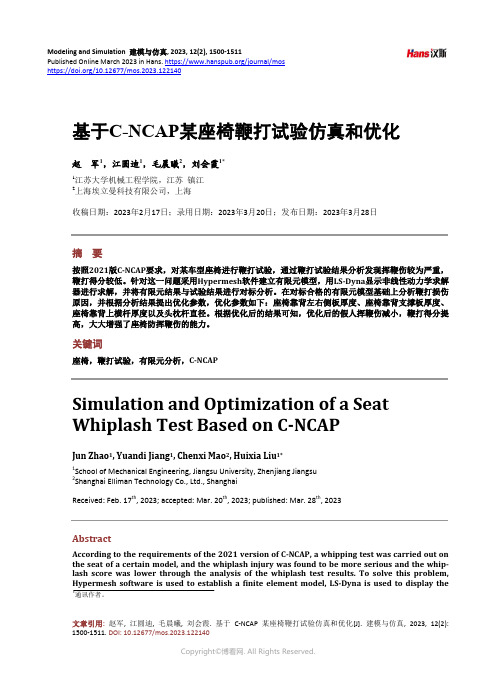
Modeling and Simulation 建模与仿真, 2023, 12(2), 1500-1511 Published Online March 2023 in Hans. https:///journal/mos https:///10.12677/mos.2023.122140基于C-NCAP 某座椅鞭打试验仿真和优化赵 军1,江圆迪1,毛晨曦2,刘会霞1*1江苏大学机械工程学院,江苏 镇江 2上海埃立曼科技有限公司,上海收稿日期:2023年2月17日;录用日期:2023年3月20日;发布日期:2023年3月28日摘要按照2021版C-NCAP 要求,对某车型座椅进行鞭打试验,通过鞭打试验结果分析发现挥鞭伤较为严重,鞭打得分较低。
针对这一问题采用Hypermesh 软件建立有限元模型,用LS-Dyna 显示非线性动力学求解器进行求解,并将有限元结果与试验结果进行对标分析。
在对标合格的有限元模型基础上分析鞭打损伤原因,并根据分析结果提出优化参数,优化参数如下:座椅靠背左右侧板厚度、座椅靠背支撑板厚度、座椅靠背上横杆厚度以及头枕杆直径。
根据优化后的结果可知,优化后的假人挥鞭伤减小,鞭打得分提高,大大增强了座椅防挥鞭伤的能力。
关键词座椅,鞭打试验,有限元分析,C-NCAPSimulation and Optimization of a Seat Whiplash Test Based on C-NCAPJun Zhao 1, Yuandi Jiang 1, Chenxi Mao 2, Huixia Liu 1*1School of Mechanical Engineering, Jiangsu University, Zhenjiang Jiangsu 2Shanghai Elliman Technology Co., Ltd., ShanghaiReceived: Feb. 17th , 2023; accepted: Mar. 20th , 2023; published: Mar. 28th , 2023AbstractAccording to the requirements of the 2021 version of C-NCAP, a whipping test was carried out on the seat of a certain model, and the whiplash injury was found to be more serious and the whip-lash score was lower through the analysis of the whiplash test results. To solve this problem, Hypermesh software is used to establish a finite element model, LS-Dyna is used to display the*通讯作者。
乙烯装置低温分离流程模拟与优化

大连理工大学专业学位硕士学位论文摘要乙烯装置是三烯的来源,是将炼厂资源转化为化工原料的关键,是现阶段国家炼化一体化进程中的龙头装置。
未来十年,我国乙烯产能将以500-600万吨/年的增速增长,故针对乙烯流程,尤其是工业装置流程的节能降耗研究十分重要。
根据裂解气组成不同,乙烯装置可选择的分离序列及换热网络组织形式千变万化。
至今,有许多针对低温分离过程中冷量与轴功进行分析的方法论问世,并不断更新进步,可对低温分离流程的分离过程及换热网络进行分析与优化,但它们更多应用在算例比对或工业装置流程片段上,较少用于工业装置全低温流程的节能降耗分析。
本文基于Aspen Plus平台对某厂乙烯装置的低温分离流程进行建模,并与该流程设计值进行比较,得到可以反映该装置真实分离效果及能耗的模型。
通过模拟计算得到的制冷机组制取冷量所需轴功消耗,与设计值比较误差低于5%,证明全流程建模过程中各冷量用户的模拟准确,模型可用于对该装置的节能降耗潜力进行分析。
通过搭建的低温分离流程模型所得的流股信息,基于Aspen Energy Analyzer平台对该装置低温分离流程全流程进行分析,结果表明该装置部分冷量与用户的匹配跨越了品位,出现高能低用的现象;总组合曲线中的“冷袋”存在降低㶲损的潜力,如优化冷量回收方式强化流程的分离过程;冷箱中的部分匹配存在冷热流股传热温差过大,㶲损较大的现象。
综上,该装置低温分离流程的换热网络存在较大节能挖潜的空间。
根据上述分析,对该装置低温分离流程进行分离过程及换热网络的优化。
针对低压脱丙烷塔进行塔总组合曲线分析,得出增设中间再沸器的优化方案,从而降低低温分离流程0.45MPaG蒸汽消耗13.6%;通过于脱甲烷单元应用低能耗乙烯分离技术,强化脱甲烷单元的分离过程,将装置乙烯产品收率由99.3%提高至99.6%;对脱乙烷-乙烯精馏单元流程进行优选及参数调优,低脱乙烷塔冷凝器负荷16.1%,并降低乙烯精馏塔塔顶气相至乙烯制冷机的气相流量8.3%。
延迟焦化装置吸收稳定系统流程模拟与优化
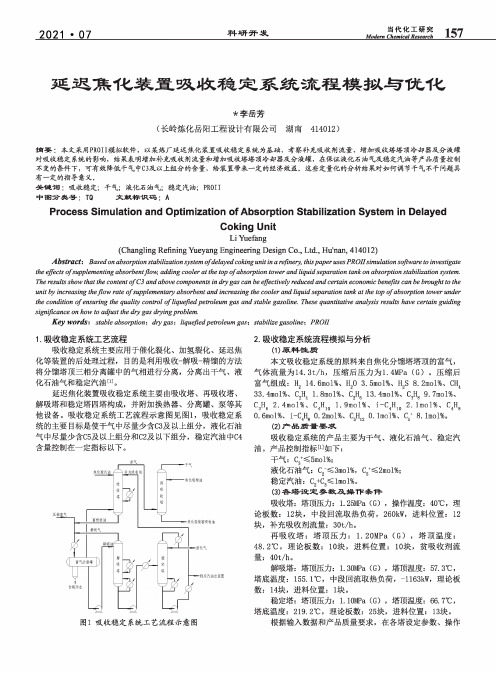
当代化工研究[耳7Modem Chemical R esedfdt丄Q/ 2021・07科研开发延迟焦化装置吸收稳定系统流程模拟与优化*李岳芳(长岭炼化岳阳工程设计有限公司湖南414012)摘要:本文采用PR0II模拟软件,以某炼厂延迟焦化装置吸收稳定系统为基础,考察补充吸收剂流量、增加吸收塔塔顶冷却器及分液罐对吸收稳定系统的影响,结果表明增加补充吸收剂流量和增加吸收塔塔顶冷却器及分液罐,在保证液化石油气及稳定汽油等产品质量控制不变的条件下,可有效降低干气中C3及以上组分的含量,给装置带来一定的经济效益。
这些定量化的分析结果对如何调节干气不干问题具有一定的指导意义.关键词:吸收稳定;干气;液化石油气;稳定汽油;PR0II中图分类号:TQ文献标识码:AProcess Simulation and Optimization of Absorption Stabilization System in DelayedCoking UnitLi Yuefang(Changling Refining Yueyang Engineering Design Co.,Ltd.,Hu!nan,414012) Abstract:Based on absorption stabilization system of d elayed c oking unit in a refinery,this p aper uses PROIIsimulation software to investigate the effects ofsupplementing absorbentflow,adding cooler at the top of a bsorption to^er and liquid separation tank on absorption stabilization system. The results show that the content of C3and above components in dry gas can be effectively reduced and certain economic benefits can be brought to the unit by increasing the f low rate of s upplementary absorbent and increasing the cooler and liquid separation tank at the top of a bsorption tower under the condition of e nsuring the quality control of l iquefied petroleum gas and stable gasoline.These quantitative analysis results have certain guiding significance on how to adjust the dry gas drying p roblem.Key words z stable absorption^dry gas;liquefied p etroleum gas;stabilize gasoline^PROII1■吸收稳定系统工艺流程吸收稳定系统主要应用于催化裂化、加氢裂化、延迟焦化等装置的后处理过程,目的是利用吸收-解吸-精馅的方法将分馅塔顶三相分离罐中的气相进行分离,分离出干气、液化石油气和稳定汽油皿。
PRO/II对液化气分馏装置丙烯精馏塔的模拟与优化

PRO/II对液化气分馏装置丙烯精馏塔的模拟与优化摘要:利用PRO/II流程模拟软件,对液化气分离装置的丙烯精馏塔进行模拟计算。
利用灵敏度分析工具,对塔压,回流比,全塔热负荷等重要参数进行优化设计。
通过改变蒸馏塔进料位置和原料的进料状态,进行优化优化计算和经济效益比较,得到操作费用最低的进料位置和进料状态。
关键字:PRO/II;丙烯精馏塔;模拟优化Simulation and Optimization of the Operation of Liquefied Petroleum Gas Separation Unit of C3-spliter with PRO/II SoftwareAbstract: Using PRO/II process simulation software, the LPG separation unit of C3-spliter to simulate calculation of the column. Using sensitivity analysis tool, tower pressure, reflux ratio and the duty and other important parameters tower optimized design. By changing the distillation tower feeding position and raw materials incoming state, optimization calculation and economic efficiency comparison, get the feed of the lowest operation cost position and incoming state.Key Word: PRO/II;C3-spliter;Simulation and Optimization液化气作为燃料利用的途径被管道天然气取代是一种趋势。
面向军工行业数字化生产线建模仿真与优化技术

·35·兵工自动化Ordnance Industry Automation2019-02 38(2)doi: 10.7690/bgzdh.2019.02.007面向军工行业数字化生产线建模仿真与优化技术徐曼菲,吴 跃,邱 枫(中国兵器装备集团自动化研究所有限公司智能制造技术研发中心,四川 绵阳 621000)摘要:针对军工行业数字化生产线大批量、多品种、混线生产模式中存在的排产调度灵活性差、布局限制资源效率发挥、过程状态掌控难等问题,提出一种适用于军工行业的数字化生产线建模仿真与优化技术解决方案。
结合国内外生产线仿真发展趋势,分析军工企业产品生产线主要现状,依据军工行业生产线场景,构建了生产系统仿真模型及仿真总体技术方案,得出我国新一代军工生产线工艺及物流优化布局。
结果表明:该方案能提高整体生产效率,缩小装备生产制造环节的短板,对军工制造行业向智能制造的转型升级有一定的实用意义。
关键词:生产线;快速建模;仿真优化;实时数据融合 中图分类号:TP391;TP278 文献标志码:AModeling Simulation and Optimization Technology ofDigital Production Line for Military IndustryXu Manfei, Wu Yue, Qiu Feng(Research & Development Center of Intelligent Manufacturing Technology ,Automation Research Institute Co ., Ltd . of China South Industries Group Corporation , Mianyang 621000, China ) Abstract: Aimed at the flexibility of production scheduling of large batch, multi variety and mixed line production mode in digital production line of military industry is poor and the layout restricts the efficiency of resources, the process state is difficult to control, a solution for modeling, simulation and optimization of digital production line for military industry is proposed. Combining with the development trend of production line simulation at home and abroad, the main status of the production line of the military enterprise is analyzed, according to the scene of the production line of the military industry, the simulation model of production system and the general technical scheme of simulation are constructed. The technological and logistics optimization layout of the new generation of military production line is obtained in China. The results show that the scheme can improve the overall production efficiency, shorten the short board of equipment manufacturing, it has some practical significance to the transformation and upgrading of the military manufacturing industry to the intelligent manufacturing.Keywords: production line; rapid modeling; simulation optimization; real time data fusion0 引言智能工厂建设是我国制造强国战略的重要组成部分。
某重载型商用车动力舱气液联合热平衡仿真与优化
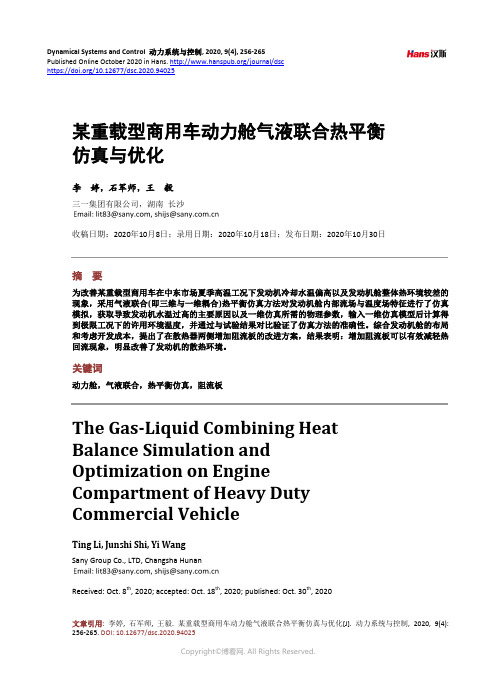
Dynamical Systems and Control 动力系统与控制, 2020, 9(4), 256-265 Published Online October 2020 in Hans. /journal/dsc https:///10.12677/dsc.2020.94025某重载型商用车动力舱气液联合热平衡 仿真与优化李 婷,石军师,王 毅三一集团有限公司,湖南 长沙收稿日期:2020年10月8日;录用日期:2020年10月18日;发布日期:2020年10月30日摘 要为改善某重载型商用车在中东市场夏季高温工况下发动机冷却水温偏高以及发动机舱整体热环境较差的现象,采用气液联合(即三维与一维耦合)热平衡仿真方法对发动机舱内部流场与温度场特征进行了仿真模拟,获取导致发动机水温过高的主要原因以及一维仿真所需的物理参数,输入一维仿真模型后计算得到极限工况下的许用环境温度,并通过与试验结果对比验证了仿真方法的准确性。
综合发动机舱的布局和考虑开发成本,提出了在散热器两侧增加阻流板的改进方案,结果表明:增加阻流板可以有效减轻热回流现象,明显改善了发动机的散热环境。
关键词动力舱,气液联合,热平衡仿真,阻流板The Gas-Liquid Combining Heat Balance Simulation and Optimization on EngineCompartment of Heavy Duty Commercial VehicleTing Li, Junshi Shi, Yi WangSany Group Co., LTD, Changsha HunanReceived: Oct. 8th , 2020; accepted: Oct. 18th , 2020; published: Oct. 30th, 2020李婷 等AbstractIn order to improve the phenomenon of high temperature of engine cooling water and poor ther-mal environment of engine compartment of heavy duty commercial vehicle in the Middle East market, the characteristics of flow field and temperature field in engine compartment were simu-lated by gas-liquid combined (i.e ., three-dimensional and one-dimensional coupling) heat balance simulation method. The main reasons for the excessive water temperature of the engine and the physical parameters required for one-dimensional simulation are obtained. The allowable am-bient temperature under the limit condition is calculated after inputting the one-dimensional si-mulation model. The accuracy of the simulation method is verified by comparing with the test re-sults. Considering the layout of the engine compartment and considering the development cost, the improvement scheme of adding baffle plates on both sides of the radiator is proposed. The re-sults show that the heat reflux phenomenon can be effectively reduced by adding the baffle plate, and the cooling environment of the engine is obviously improved.KeywordsEngine Compartment, Gas-Liquid Combining, Heat Balance Simulation, Baffle PlatesCopyright © 2020 by author(s) and Hans Publishers Inc.This work is licensed under the Creative Commons Attribution International License (CC BY 4.0). /licenses/by/4.0/1. 引言随着市场对重载型商用车大马力、高能效的需求越来越强烈,发动机热负荷将大幅提高[1],发动机舱散热问题日益严峻,若冷却系统匹配不合理,发动机在极限工况下作业易出现冷却水“开锅”现象,导致车辆无法正常使用。
基于flexsim的仓库作业流程的仿真与优化
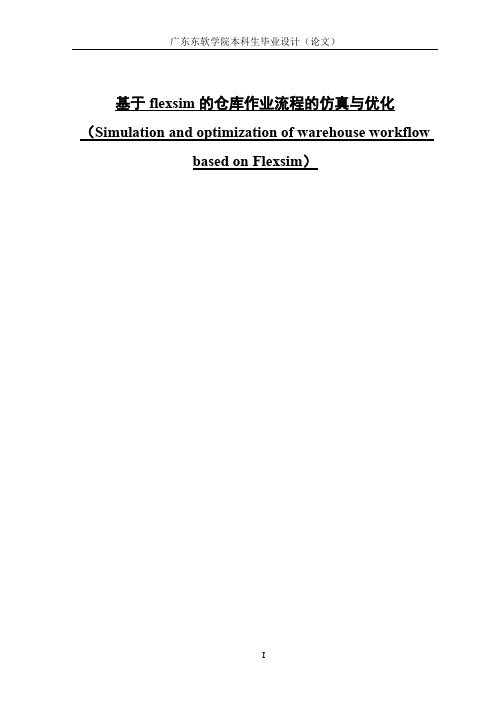
1.2.2
本文将以A公司配送仓为研究对象,研究内容如下图1-1所示
图1-1研究内容
先实地考察A公司配送仓,了解总体情况并获取模型搭建所需的信息,比如进出库的作业流程,货架的数量,打包台的数量、员工的数量以及货Байду номын сангаас出库所需的时间等等。对资料进行分析整合,利用Felxsim软件搭建初步模型,对仓库作业中存在的问题进行优化分析,提出优化方案和改进措施,对模型进行仿真优化,得出最优方案。
2.1.3
物流仿真系统主要用于对物流系统的作业流程进行仿真建模,从而在模型中找出各个环节的潜在问题,让我们可以更直观更方便的对整个物流系统进行评价。
它是一种运用电脑技术,数学技术和人工智能技术对现实中的环境进行模拟仿真的软件,最后以3D的形式把模拟的环境整个呈现出来。
目前,市面上运用得最多的仿真软件主要有Flexsim、Vensim、Supply chain guru、Classwarehouse等等。
2
2.1
2.1.1
仓储管理,顾名思义,是对仓库和仓库中储存物料的管理。现代企业的仓库已成为企业核心。在新的经济和新的竞争形势下,企业在注重效益的同时,更加注重合理的仓储管理,不断挖掘和发展自身的竞争力。准确的仓库管理能够有效地控制和降低流通和库存成本,是企业保持优势的关键支撑和保证。仓储管理的重点不仅在于物料的安全储存,还在于如何运用信息技术、自动化技术等现代技术,提高仓储作业的速度和效率[5]。这也是自动化立体仓库有自己的方式的原因。
Advanced Design System - 2002_S-parameter Simulation and Optimization

Slide 5 - 9
Creating Matching Networks
• Various topologies can be used: L, C, R • Avoid unwanted oscillations (L-C series/parallel) • Yield can be a factor in topology (sensitivity) • Use the fewest components (cost + efficient) • Sweep or tune component values to see S-parameters • Optimization: use to meet S-parameter specs (goals)
Turn on for SS noise. If more than 2 ports, specify for 2 port NF. If not, leave blank.
Next, Sweep plan...
ADS 2002 Fundamentals - April, 2002
Slide 5 - 7
NOTE: ADS has both continuous and discrete optimization. Yield analysis or a yield optimization is also available.
ADS Optimization in schematic…
ADS 2002 Fundamentals - April, 2002
Slide 5 - 12
Four elements for Optimization setup
1 - Optim controller: set the type, etc.
光伏行业必读的书籍
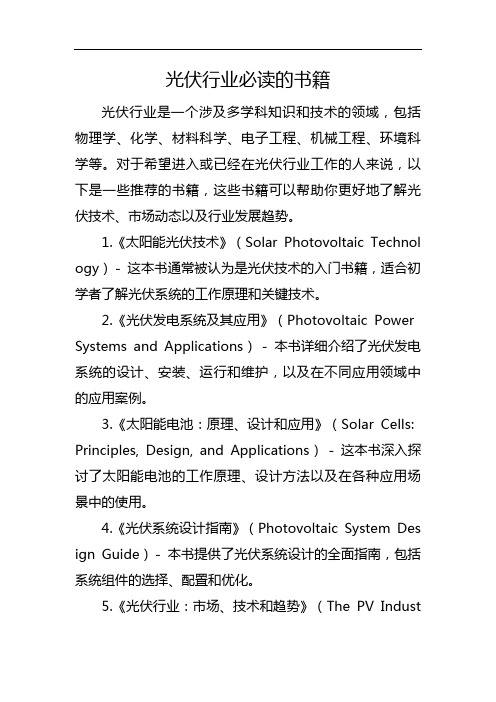
光伏行业必读的书籍光伏行业是一个涉及多学科知识和技术的领域,包括物理学、化学、材料科学、电子工程、机械工程、环境科学等。
对于希望进入或已经在光伏行业工作的人来说,以下是一些推荐的书籍,这些书籍可以帮助你更好地了解光伏技术、市场动态以及行业发展趋势。
1.《太阳能光伏技术》(Solar Photovoltaic Technol ogy)- 这本书通常被认为是光伏技术的入门书籍,适合初学者了解光伏系统的工作原理和关键技术。
2.《光伏发电系统及其应用》(Photovoltaic Power Systems and Applications)- 本书详细介绍了光伏发电系统的设计、安装、运行和维护,以及在不同应用领域中的应用案例。
3.《太阳能电池:原理、设计和应用》(Solar Cells: Principles, Design, and Applications)- 这本书深入探讨了太阳能电池的工作原理、设计方法以及在各种应用场景中的使用。
4.《光伏系统设计指南》(Photovoltaic System Des ign Guide)- 本书提供了光伏系统设计的全面指南,包括系统组件的选择、配置和优化。
5.《光伏行业:市场、技术和趋势》(The PV Industry: Market, Technology and Trends)- 这本书分析了光伏行业的市场动态、技术进步和未来发展趋势。
6.《光伏项目管理:从规划到运营》(Photovoltaic P roject Management: From Planning to Operation)- 本书涵盖了光伏项目管理的各个方面,包括项目规划、融资、安装、运营和维护。
7.《光伏系统仿真与优化》(Simulation and Optimi zation of Photovoltaic Systems)- 这本书介绍了如何使用仿真工具来设计和优化光伏系统,以提高其性能和效率。
磁等离子体动力推力器加速机理研究与仿真
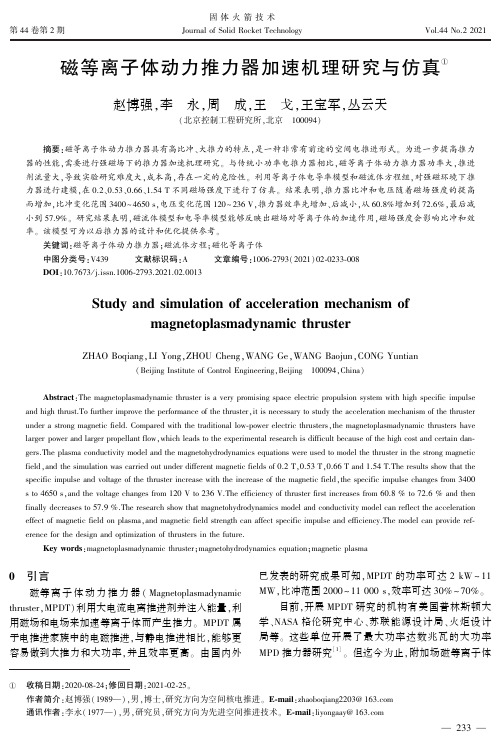
under a strong magnetic field. Compared with the traditional low⁃power electric thrusters,the magnetoplasmadynamic thrusters have
larger power and larger propellant flow,which leads to the experimental research is difficult because of the high cost and certain dan⁃
gers.The plasma conductivity model and the magnetohydrodynamics equations were used to model the thruster in the strong magnetic
field,and the simulation was carried out under different magnetic fields of 0.2 T,0.53 T,0.66 T and 1.54 T.The results show that the
erence for the design and optimization of thrusters in the future.
Key words:magnetoplasmadynamic thruster;magnetohydrodynamics equation;magnetic plasma
F =-
1
e2
× 2
4π 0
r0
(6)
足够精确[10,12] 。 同时,MPDT 中等离子体电子温度 KT
基于数学模型的DPF再生控制策略仿真和优化
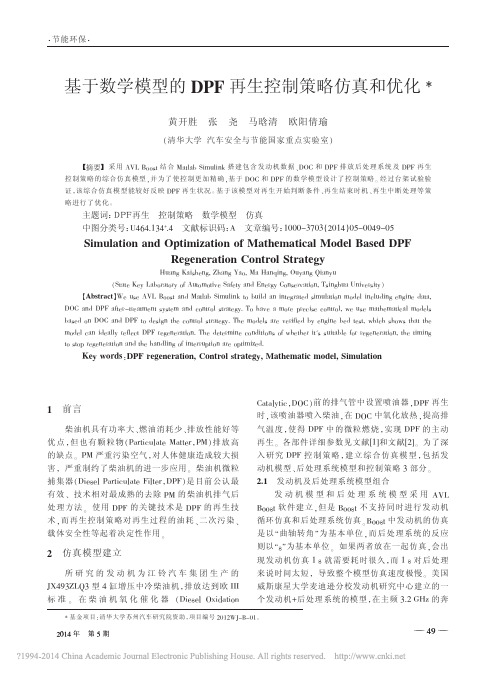
3 仿真模型验证
模型建立后在发动机台架上进行试验验证。该发动 机台架采用普联 FC2000 台架测控系统,采用 HORIBA 的 MEXA-7100D 排气分析仪、MDLT-1300T 颗粒物检 测仪,DOC、DPF 和排气道燃油系统由天纳克公司封装 提供,控制器采用 Mototron 快速原型开发工具,上位机 采 用 LabView 数 据 采 集 平 台 , 通 过 CAN 通 讯 与 Mototron 控制器相连。 发动机台架结构如图 4 所示。
(1)
式中,ρDOC 、cDOC 、VDOC 分别为 DOC 的密度、 比热容、
体积;ρexh 、cexh 、Vexh 分别为 DOC 中排气的密度、比热
容 和 体 积 ;Q觶 HC 为 燃 油 放 热 的 速 率 ;m觶 exh 为 排 气 质 量
流 量 ; m觶 HC 为 喷 油 速 率 ;c p.exh 为 排 气 等 压 比 热 容 ; T 为 DOC 出 口 温 度 ;TDOC,in 为 DOC 入口温度。
和 DOC 入口温度变化曲线如图 3 所示。
—— 50 ——
根据发动机工况 和目标温度计算 需求喷油量
喷 油 PWM 输出
DOC 输 出 温 度 >目标温度
是
否
PID 控 制 器 减少喷油量
PID 控 制 器 增加喷油量
图 1 DOC 出口温度控制流程
800
40
喷油 PWM/%
600
30
温 度/℃
甲基丙烯酸甲酯甲醇水共沸体系变压精馏分离工艺的模拟与优化
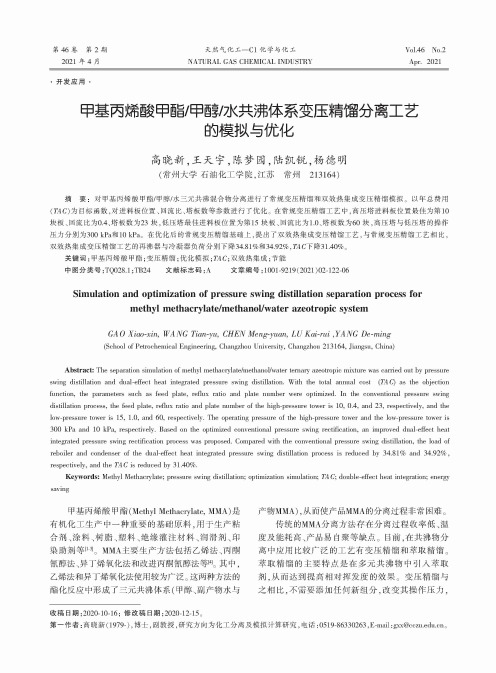
第46卷第2期 2021年4月天然气化工一C1化学与化工NATURAL GAS CHEMICAL INDUSTRYVol.46 No.2Apr. 2021•开发应用•甲基丙烯酸甲酯/甲醇/水共沸体系变压精馏分离工艺的模拟与优化高晓新,王天宇,陈梦园,陆凯锐,杨德明(常州大学石油化工学院,江苏常州213164)摘要:对甲基丙烯酸甲酯/甲醇/水三元共沸混合物分离进行了常规变压精馏和双效热集成变压精馏模拟。
以年总费用 (TAC)为目标函数,对进料板位置、回流比、塔板数等参数进行了优化。
在常规变压精馏工艺中,高压塔进料板位置最佳为第10块板、回流比为0.4、塔板数为23块,低压塔最佳进料板位置为第15块板、回流比为1.0、塔板数为60块,高压塔与低压塔的操作 压力分别为300 kPa和10kPa。
在优化后的常规变压精馏基础上,提出了双效热集成变压精馏工艺,与常规变压精馏工艺相比,双效热集成变压精馏工艺的再沸器与冷凝器负荷分别下降34.81%和34.92%,TAC下降31.40%。
关键词:甲基丙烯酸甲酯;变压精馏;优化模拟;TAC;双效热集成;节能中图分类号:TQ028.1 ;TB24 文献标志码:A 文章编号:1001-9219(2021 )02-122-06Simulation and optimization of pressure swing distillation separation process formethyl methacrylate/methanol/water azeotropic systemGAO Xiao-xin, WANG Tian-yu, CHEN Meng-yuan, LU Kai-rui ,YANG De-ming(School of Petrochemical Engineering, Changzhou University, Changzhou 213164, Jiangsu, China)Abstract: The separation simulation of methyl methacrylate/methanol/water ternary azeotropic mixture was carried out by pressure swing distillation and dual-effect heat integrated pressure swing distillation. With the total annual cost (TA C) as the objection function, the parameters such as feed plate, reflux ratio and plate number were optimized. In the conventional pressure swing distillation process, the feed plate, reflux ratio and plate number of the high-pressure tower is 10, 0.4, and 23, respectively, and the low-pressure tower is 15, 1.0, and 60, respectively. The operating pressure of the high-pressure tower and the low-pressure tower is 300 kPa and 10 kPa, respectively. Based on the optimized conventional pressure swing rectification, an improved dual-effect heat integrated pressure swing rectification process was proposed. Compared with the conventional pressure swing distillation, the load of reboiler and condenser of the dual-effect heat integrated pressure swing distillation process is reduced by 34.81% and 34.92%, respectively, and the T A C is reduced by 31.40%.Keywords: Methyl Methacrylate; pressure swing distillation; optimization simulation; TA C; double-effect heat integration; energy saving甲基丙烯酸甲酯(Methyl Methacrylate,MMA)是 有机化工生产中一种重要的基础原料,用于生产粘 合剂、涂料、树脂、塑料、绝缘灌注材料、润滑剂、印染助剂等[1-3]。
某型纯电动汽车路噪仿真与优化
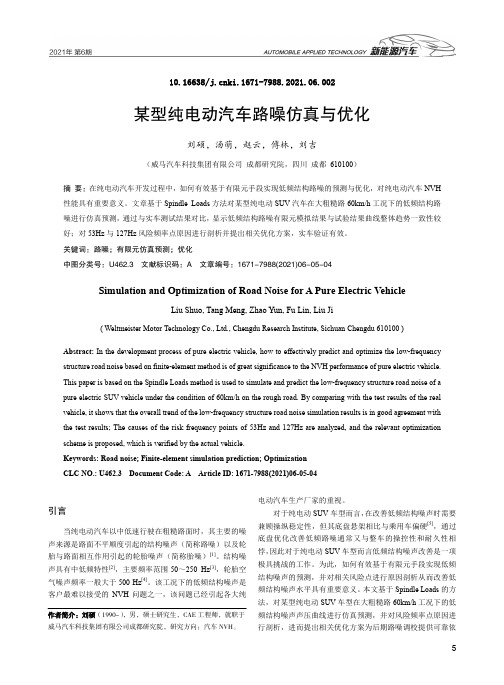
10.16638/ki.1671-7988.2021.06.002某型纯电动汽车路噪仿真与优化刘硕,汤萌,赵云,傅林,刘吉(威马汽车科技集团有限公司成都研究院,四川成都610100)摘要:在纯电动汽车开发过程中,如何有效基于有限元手段实现低频结构路噪的预测与优化,对纯电动汽车NVH 性能具有重要意义。
文章基于Spindle Loads方法对某型纯电动SUV汽车在大粗糙路60km/h工况下的低频结构路噪进行仿真预测,通过与实车测试结果对比,显示低频结构路噪有限元模拟结果与试验结果曲线整体趋势一致性较好;对53Hz与127Hz风险频率点原因进行剖析并提出相关优化方案,实车验证有效。
关键词:路噪;有限元仿真预测;优化中图分类号:U462.3 文献标识码:A 文章编号:1671-7988(2021)06-05-04Simulation and Optimization of Road Noise for A Pure Electric VehicleLiu Shuo, Tang Meng, Zhao Yun, Fu Lin, Liu Ji( Weltmeister Motor Technology Co., Ltd., Chengdu Research Institute, Sichuan Chengdu 610100 )Abstract: In the development process of pure electric vehicle, how to effectively predict and optimize the low-frequency structure road noise based on finite-element method is of great significance to the NVH performance of pure electric vehicle. This paper is based on the Spindle Loads method is used to simulate and predict the low-frequency structure road noise of a pure electric SUV vehicle under the condition of 60km/h on the rough road. By comparing with the test results of the real vehicle, it shows that the overall trend of the low-frequency structure road noise simulation results is in good agreement with the test results; The causes of the risk frequency points of 53Hz and 127Hz are analyzed, and the relevant optimization scheme is proposed, which is verified by the actual vehicle.Keywords: Road noise; Finite-element simulation prediction; OptimizationCLC NO.: U462.3 Document Code: A Article ID: 1671-7988(2021)06-05-04引言当纯电动汽车以中低速行驶在粗糙路面时,其主要的噪声来源是路面不平顺度引起的结构噪声(简称路噪)以及轮胎与路面相互作用引起的轮胎噪声(简称胎噪)[1]。
土木工程毕业设计外文翻译CFD模拟和地铁站台的优化通风
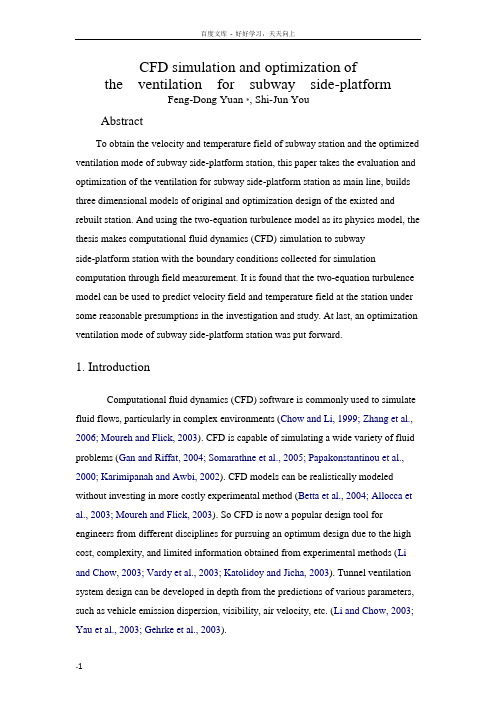
CFD simulation and optimization ofthe ventilation for subway side-platformFeng-Dong Yuan *, Shi-Jun YouAbstractTo obtain the velocity and temperature field of subway station and the optimized ventilation mode of subway side-platform station, this paper takes the evaluation and optimization of the ventilation for subway side-platform station as main line, builds three dimensional models of original and optimization design of the existed and rebuilt station. And using the two-equation turbulence model as its physics model, the thesis makes computational fluid dynamics (CFD) simulation to subwayside-platform station with the boundary conditions collected for simulation computation through field measurement. It is found that the two-equation turbulence model can be used to predict velocity field and temperature field at the station under some reasonable presumptions in the investigation and study. At last, an optimization ventilation mode of subway side-platform station was put forward.1. IntroductionComputational fluid dynamics (CFD) software is commonly used to simulate fluid flows, particularly in complex environments (Chow and Li, 1999; Zhang et al., 2006;Moureh and Flick, 2003). CFD is capable of simulating a wide variety of fluid problems (Gan and Riffat, 2004;Somarathne et al., 2005; Papakonstantinou et al., 2000;Karimipanah and Awbi, 2002). CFD models can be realistically modeled without investing in more costly experimental method (Betta et al., 2004; Allocca et al., 2003;Moureh and Flick, 2003). So CFD is now a popular design tool for engineers from different disciplines for pursuing an optimum design due to the high cost, complexity, and limited information obtained from experimental methods (Li and Chow, 2003; Vardy et al., 2003; Katolidoy and Jicha,2003). Tunnel ventilation system design can be developed in depth from the predictions of various parameters, such as vehicle emission dispersion, visibility, air velocity, etc. (Li and Chow, 2003; Yau et al., 2003; Gehrke et al., 2003).Earlier CFD simulations of tunnel ventilation system mainly focus on emergency situation as fire condition (Modic, 2003; Carvel et al., 2001; Casale, 2003). Many scientists and research workers (Waterson and Lavedrine,2003; Sigl and Rieker, 2000; Gao et al., 2004; Tajadura et al., 2006) have done much work on this. This paper studied the performance of CFD simulation on subway environment control system which has not been studied by other paper or research report. It is essential to calculate and simulate the different designs before the construction begins, since the investment in subway’s construction is huge and the subway should run up for a few decade years. The ventilation of subway is crucial that the passengers should have fresh and high quality air (Lowndes et al.,2004; Luo and Roux, 2004). Then if emergency occurred that the well-designed ventilation system can save many people’s life and belongings (Chow and Li, 1999; Modic,2003; Carvel et al., 2001). The characteristics of emergency situation have been well investigated, but there have been few studies in air distribution of side-platform in normal conditions.The development of large capacity and high speed computer and computational fluid dynamics technology makes it possible to use CFD technology to predict the air distribution and optimize the design project of subway ventilation system. Based on the human-oriented design intention in subway ventilation system, this study simulated and analyzed the ventilation system of existent station and original design of rebuilt stations of Tianjin subway in China with the professional software AIRPAK, and then found the optimum ventilation project for the ventilation and structure of rebuilt stations.2. Ventilation systemTianjin Metro, the secondly-built subway in China, will be rebuilt to meet the demand of urban development and expected to be available for Beijing 2008 Olympic Games. The existent subway has eight stations, with a total length of km and a km average interval. For sake of saving the cost of engineering, the existent subway will continue to run and the stations will be rebuilt in the rebuilding Line 1 of Tianjin subway. Although different existent stations of Tianjin Metro have differentstructures and geometries, the Southwest Station is the most typical one. So the Southwest Station model was used to simulate and analyze in the study. Its geometry model is shown in Fig. 1.. The structure and original ventilation mode of existent stationT he subway has two run-lines. The structure of Southwest Station is, length width height = m(L) m(W) m(H), which is a typical side-platform station. Each side has only one passageway (length height = m(L) m(H)). The middle of station is the space for passengers to wait for the vehicle. The platform mechanical ventilation is realized with two jet openings located at each end of station and the supply air jets towards train and track. There is no mechanical exhaust system at the station and air is removed mechanically by tunnel fans and naturally by the exits of the station.. The design structure and ventilation of rebuilt stationThe predicted passenger flow volume increase greatly and the dimension of the original station is too small, so in the rebuilding design, the structure of subway station is changed to, (length width height = 132 m(L) m(W) m(H)), and each side has two passageways. The design volume flow of Southwest Station is 400000 m3/h. For most existent stations, the platform height is only m, which is too low to set ceiling ducts.So in the original design, there are two grille vents at each end of the platform to supply fresh air along the platform length direction and two grille vents to jet air breadthways towards trains. The design velocity of each lengthways grille vent ism/s. For each breadthways vent, it is m/s. Under the platform, 80 grille vents of the same velocity m/s, 40 for each platform of the station) are responsible for exhaust.3. CFD simulation and optimizationThe application of CFD simulation in the indoor environment is based on conversation equations of energy, mass and momentum of incompressible air. The study adopted a turbulence energy model that is the two-equation turbulence model advanced by Launder and Spalding. And it integrated the governing equation on the capital control volumes and discretized in the definite grids, at last simulated andcomputed with the AIRPAK software.. Preceding simplifications and presumptionsBecause of mechanical ventilation and the existence of train-driven piston wind, the turbulence on platform is transient and complex. Unless some simplifications and presumptions are made, the mathematics model of three-dimensional flow is not expressed and the result is divergent. While ensuring the reliability of the computation results, some preceding simplifications and presumptions have to be taken.(1)The period of maximum air velocity is paid attention to in the transient process.Apparently the maximum air velocity is reached at the period when train stops at or starts away from the station (Yau et al., 2003;Gehrke et al., 2003), so theperiod the simulation concerns about the best period of time for simulation is from the point when at the section of ‘x = m’ (Fig. 1) and the air velocity begin to change under piston-effect to the point when train totally stops at the station (defined as a ‘pulling-in cycle’).(2) Though the pulling-in cycle is a transient process, it is simplified to a steady process.(3) Because the process is presumed to a steady process, the transient velocity of test sections, which was tested in Southwest Station in pulling-in cycle, is presumed to the time-averaged velocity of test sections.(4) The volume flow driven into the station by pulling-in train is determined by such factors as BR (blocking ratio, the ratio of train cross-section area to tunnelcross-section area), the length of the train and the resistance of station etc. For existent and new stations, BRs are almost the same. Although the length of the lattertrain doubles that of the former which may increase the piston flow volume, the resistance of latter is greater than that of the former which may counteract thisincrease. So it is presumed that the piston flow volume is same for both existent and new station and that the volume flow through the passenger exits is also same. Based on this presumption, the results of the field measurements at the existent station can be used as velocity boundary conditions to predict velocity filed of new station .. Original conditionsTo obtain the boundary conditions for computation and simulation, such as the air velocity and temperature of enclosure, measures were done by times at Southwest Station.All data are recorded during a complete pulling-in cycle. The air velocities were measured by the multichannel anemone-master hotwire anemoscope and infrared thermometer is used to measure the temperature of the walls of the station which are taken as the constant temperature thermal conditions in the simulation.Temperatures of enclosureDivide the platform into five segments and select some typical test positions. The distributing temperature of enclosure is shown in Table 1. It can be seen from Table 1 that all temperatures of enclosure are between 23 _C and 25 _C, there is littledifference in all test positions, and the average temperature is 24 _C. So alltemperatures of subway station’s walls is 24 _C in CFD computation and simulation.Time-averaged air velocity above the platformFig. 1 is the location of test section and the layout of measuring points. The data measured include 12 transient velocities in each section (A –H in Fig. 1), which were deal with section’s time -averaged velocities in the period, 12 point’s velocities ofpassageway, which is used to acquire the average flow, and the velocities of each end of station, which is used to acquire the average piston flow volume.Fig. 2 is the lengthways velocities measured of platform sections, max V is themaximum air velocity, min V is the minimum air velocity and avc V is the average air velocity. Fig. 2 shows that the maximum air velocity is at the passageway. At thepassageway the change of air velocity is about m/s, which is the maximum and indicates that the passageway is the position effected most by the piston wind effect, and the air velocity of section D and E after the passageway is almost the same, which indicates that the piston wind can hardly effect the air velocity after the passageway.CFD模拟和地铁站台的优化通风Feng-Dong Yuan *, Shi-Jun You摘要获得车站的速度和温度领域同时地铁站台的最优方式。
甲烷化反应器的Aspen Plus模拟与优化

20 期 第
Aspen Plus拟 与 优 化
127· ·
甲 烷 化 反 应 器 的 拟 与 优 化 Aspen Plus 模
彭 淑 静 , 周 艳 军 , 娄 玉 爽
㊀ 121001 ) ( 辽 宁 工 业 大 学 化 学 与 环 境 工 程 学 院 , 辽 宁 锦 州
摘 要 : Aspen Plus 化 利 用 工 流 程 模 拟 软 件 , 分 别 选 择 平 衡 反 应 器 和 平 推 流 反 应 器 模 型 , 对 锦 西 天 然 气 化 工 有 限 公 司 甲 烷 化 反 应 器 进 行 了 模 拟 , 并 将 模 拟 结 果 与 工 厂 的 实 际 数 据 进 行 了 比 较 与 分 析 。通 过 考 察 温 度 和 压 力 对 甲 烷 等 组 分 含 量 的 影 响 , 确 定 了 适 宜 的 温 度 和 压 力 , 实 现 了 对 甲 烷 化 反 应 器 优 化 的 目 的 。 Aspen Plus; 关 键 词 : 甲 烷 化 反 应 器 ; 模 拟 ; 优 化 TQ223. 12㊀ ㊀ ㊀ ㊀ ㊀ 文 A㊀ ㊀ ㊀ ㊀ 文 1008 - 021X( 2017 ) 20 - 0127 - 02 中 图 分 类 号 : 献 标 识 码 : 章 编 号 :
Simulation and Optimization of Methanation Equipment
Peng Shujing Zhou Yanjun Lou Yushuang
Chemical & Environmental Engineering College,Liaoning University of Technology,Jinzhou㊀ 121001 ,China) ( Abstract: The methanation reactor based on the actual production of Jinxi Natural Gas Chemical Co. ,Ltd was simulated by means of Aspen Plus software with equilibrium and plug flow model,respectively. The simulation results were studied and compared with the actual data of factory as well. The effects of temperature and pressure on the content of methanation and other components were analyzed and appropriate temperature and pressure conditions were determined. The optimization of methanation reactor was preliminary established. Key words methanation reactor Aspen Plus simulation optimization
水平圆锥式分配器内两相流动分配模拟及优化设计
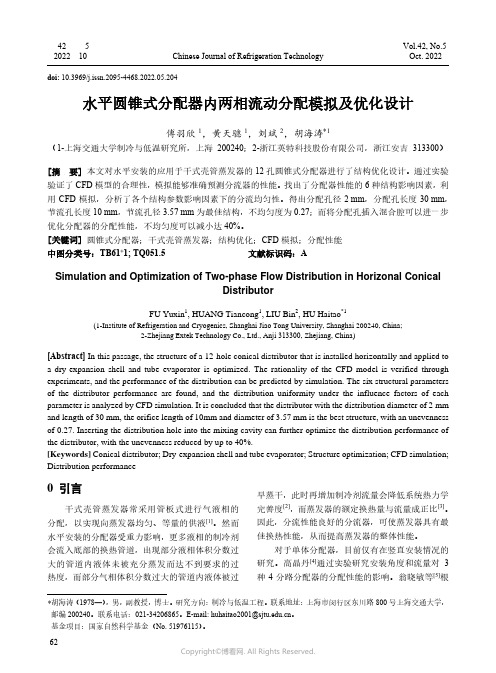
doi: 10.3969/j.issn.2095-4468.2022.05.204水平圆锥式分配器内两相流动分配模拟及优化设计傅羽欣1,黄天骢1,刘斌2,胡海涛*1(1-上海交通大学制冷与低温研究所,上海 200240;2-浙江英特科技股份有限公司,浙江安吉 313300) [摘 要] 本文对水平安装的应用于干式壳管蒸发器的12孔圆锥式分配器进行了结构优化设计。
通过实验验证了CFD 模型的合理性,模拟能够准确预测分流器的性能。
找出了分配器性能的6种结构影响因素,利用CFD 模拟,分析了各个结构参数影响因素下的分流均匀性。
得出分配孔径2 mm ,分配孔长度30 mm ,节流孔长度10 mm ,节流孔径3.57 mm 为最佳结构,不均匀度为0.27;而将分配孔插入混合腔可以进一步优化分配器的分配性能,不均匀度可以减小达40%。
[关键词] 圆锥式分配器;干式壳管蒸发器;结构优化;CFD 模拟;分配性能 中图分类号:TB61+1; TQ051.5文献标识码:ASimulation and Optimization of Two-phase Flow Distribution in Horizonal ConicalDistributorFU Yuxin 1, HUANG Tiancong 1, LIU Bin 2, HU Haitao *1(1-Institute of Refrigeration and Cryogenics, Shanghai Jiao Tong University, Shanghai 200240, China;2-Zhejiang Extek Technology Co., Ltd., Anji 313300, Zhejiang, China)[Abstract] In this passage, the structure of a 12-hole conical distributor that is installed horizontally and applied to a dry-expansion shell and tube evaporator is optimized. The rationality of the CFD model is verified through experiments, and the performance of the distribution can be predicted by simulation. The six structural parameters of the distributor performance are found, and the distribution uniformity under the influence factors of each parameter is analyzed by CFD simulation. It is concluded that the distributor with the distribution diameter of 2 mm and length of 30 mm, the orifice length of 10mm and diameter of 3.57 mm is the best structure, with an unevenness of 0.27. Inserting the distribution hole into the mixing cavity can further optimize the distribution performance of the distributor, with the unevenness reduced by up to 40%.[Keywords] Conical distributor; Dry-expansion shell and tube evaporator; Structure optimization; CFD simulation; Distribution performance0 引言干式壳管蒸发器常采用管板式进行气液相的分配,以实现向蒸发器均匀、等量的供液[1]。
- 1、下载文档前请自行甄别文档内容的完整性,平台不提供额外的编辑、内容补充、找答案等附加服务。
- 2、"仅部分预览"的文档,不可在线预览部分如存在完整性等问题,可反馈申请退款(可完整预览的文档不适用该条件!)。
- 3、如文档侵犯您的权益,请联系客服反馈,我们会尽快为您处理(人工客服工作时间:9:00-18:30)。
Physics and Simulation of Optoelectronic Devices VIII, ed. R. Binder, P. Blood & M. Osinski, SPIE Proc. 3944, 2000.Simulation and Optimization of 420 nm InGaN/GaN Laser DiodesJoachim Piprek*a, R. Kehl Sink a, Monica A. Hansen b, John E. Bowers a, and Steve P. DenBaars ba Electrical and Computer Engineering Departmentb Materials DepartmentUniversity of California at Santa Barbara, Santa Barbara, CA 93106ABSTRACTUsing self-consistent laser simulation, we analyze the performance of nitride Fabry-Perot laser diodes grown on sapphire. The active region contains three 4 nm InGaN quantum wells. It is sandwiched between GaN separate confinement layers and superlattice AlGaN/GaN cladding layers. AlGaN is used as an electron barrier layer. Pulsed lasing is measured near 420 nm wavelength and at temperatures up to 120o C. Advanced laser simulation is applied to link microscopic device physics to measurable device performance. Our two-dimensional laser model considers carrier drift and diffusion including thermionic emission at hetero-boundaries. The local optical gain is calculated from the wurtzite band structure employing a non-Lorentzian line broadening model. All material parameters used in the model are evaluated based on recent literature values as well as our own experimental data. Simulation results are in good agreement with measurements. Multi-lateral mode lasing is calculated with a high order vertical mode. The carrier distribution among quantum wells is found to be strongly non-uniform leading to a parasitic (absorbing) quantum well. The influence of defect recombination, vertical carrier leakage and lateral current spreading is investigated. The reduction of such carrier losses is important to achieve lower threshold currents and less self-heating. Several device optimization options are proposed. Elimination of the parasitic quantum well is shown to substantially enhance the device performance.Keywords: InGaN, blue laser diode, nitride semiconductor laser, quantum well devices, numerical analysis, semiconductor device modeling1. INTRODUCTIONViolet InGaN/GaN laser diodes have been pioneered by Nakamura et al.1 and are now commercially available.2 These laser diodes have potential in a number of applications such as optical storage, printing, full-color displays, chemical sensors and medical applications. The data capacity of digital versatile disks (DVDs) can be increased from 4.7 to more than 15 gigabites by using InGaN lasers instead of red AlInGaP lasers.1 The estimated InGaN laser lifetime under room-temperature (RT) continuous-wave (CW) operation has been improved to more than 10,000 hours by using laterally epitaxially overgrown GaN as substrate and AlGaN/GaN strained-layer superlattices (SLS) as cladding layers.3 Threshold current densities as low as 1.2 kA/cm2 were achieved using In0.15Ga0.85N quantum wells (QWs).4 Fundamental transverse mode operation up to 30 mW output power and with a slope efficiency as high as 1 W/A was obtained using a ridge-waveguide laser with 2 µm ridge width.5 These lasers have cleaved facets with one facet coated by two pairs of quarter-wave TiO2/SiO2 dielectric multilayers. Since the first announcement of a nitride laser diode by Nakamura et al. in December 1995, more than 10 other research groups have succeeded in fabricating similar laser diodes. However, only about half of these groups have achieved RT-CW lasing so far.6 In 1997, researchers of our university demonstrated an InGaN laser diode employing uncoated reactive ion etched (RIE) facets.7 The structural properties of RIE facets are far from ideal leading to poor optical feedback. Despite several design improvements during the last two years, RT-CW operation has not yet been achieved with these RIE lasers.8 Major technological challenges remain as well as the need for a more detailed understanding of nitride laser physics. Advanced numerical laser simulation can help to establish quantitative links between microscopic material properties and measured device performance.* Correspondence: Email: piprek@, WWW: /~piprek, Telephone: 805-893-4051In this paper, we present first results of a self-consistent numerical simulation of our InGaN laser diodes. We use a commercial laser diode software package 9 that combines band structure and gain calculations with two-dimensional (2D) simulations of wave guiding, current flow, and heat flux. The model considers carrier drift and diffusion including thermionic emission at hetero-boundaries. This allows for a study of vertical carrier leakage, lateral current spreading, and defect recombination. The reduction of such carrier losses is important to achieve lower threshold currents and less self-heating. The local optical gain is calculated from the wurtzite band structure including valence mixing and strain effects. A non-Lorentzian line broadening model is utilized and many-body effects are considered. Transversal multimode lasing is taken into account including higher order vertical modes. Such a comprehensive model requires more than 40 material parameters per epitaxial layer, most of which are not exactly known. We carefully evaluated all material parameters based on recent literature values as well as our own experimental data. However, material parameters remain the main source of uncertainty in our model.Section 2 gives a brief description of device structure and experimental results. Section 3 provides details of the theoretical model and of material parameters used. Section 4 presents a microscopic analysis of laser physics based on simulation results. Section 5 discusses device optimization options.0510152025303540050010001500200025003000L i g h t O u t p u t (m W )Current (mA)Fig. 1: Schematic cross section of our laser diodes. Fig. 2: Measured light vs. current characteristics.2. DEVICE STRUCTURE AND EXPERIMENTAL RESULTSThe schematic structure of our InGaN multiple-quantum-well (MQW) laser diodes is given in Fig. 1. The laser is grown on a lateral epitaxial overgrowth (LEO) GaN substrate to reduce the dislocation density. Details of growth and processing are described elsewhere.10 Table 1 lists compositions, layer thicknesses, and doping densities. To achieve sufficient waveguiding, the Al 0.09G a 0.91N cladding regions need to be relatively thick and they are grown as Al 0.18G a 0.82N/GaN superlattices. Laser facets are formed by Cl 2 reactive ion etching (RIE) of 45 µm wide mesas of various lengths ranging from L = 400 µm to 1600 µm. Contact stripes are patterned on these mesas with widths ranging from W = 5 µm to 15 µm. The structure was etched around the p-contact stripe through the p-cladding for index guiding. The n- and p-contacts are formed by electron beam evaporation of Ti/Al and Pd/Au, respectively. Electrical testing was performed using 50 ns pulses with a 1 kHz pulse repetition rate. Figure 2 shows the typical pulsed light output per uncoated facet of a laser diode grown on LEO GaN and a laser diode grown on planar GaN as a function of forward current. Due to a reduction in nonradiative recombination, the minimum threshold current density j th is reduced from 10 kA/cm 2 for laser diodes grown on planar GaN to 4.8 kA/cm 2 for laser diodes grown on LEO GaN. The latter exhibit an improved slope efficiency ηd up to 3.2 % per facet. However, there are large variations among devices and typical numbers for LEO GaN lasers as shown in Fig. 2 are j th = 12 kA/cm 2 and ηd = 0.04 W/A = 1.3% (W=5 µm, L=1600 µm). The measured slope efficiency does not represent the entire lightemitted on each side. About 60 % of the light power is not detected, which is attributed to photon scattering at the rough RIE facet, to its tilted angle, and to laser beam interference with the remaining GaN substrate.11 The facet reflectance is estimated to be only R = 0.05, considerably less than the ideal value of 0.18.12 Considering these numbers, the inverse slope efficiency vs. cavity length plot gives ηi = 22 % internal efficiency and αi = 42 cm-1 internal optical loss for our LEO GaN lasers.10LAYER MATERIAL THICKNESS [nm] DOPING [1018cm-3]contact GaN 100 75 (Mg)cladding Al0.18G a0.82N/GaN SL 451 75 (Mg)waveguide GaN 90 75 (Mg)electron stopper Al0.2G a0.8N 20 100 (Mg)waveguide GaN 8.5 0.05 (Si)barrier In0.04G a0.96N 8.5 0.05 (Si)quantum well In0.13G a0.87N 4.0 0.05 (Si)barrier In0.04G a0.96N 8.5 6.5 (Si)quantum well In0.13G a0.87N 4.0 0.05 (Si)barrier In0.04G a0.96N 8.5 6.5 (Si)quantum well In0.13G a0.87N 4.0 0.05 (Si)barrier In0.04G a0.96N 8.5 6.5 (Si)waveguide GaN 98.5 6.5 (Si)cladding Al0.18G a0.82N/GaN SL 451 2.0 (Si)compliance layer In0.05G a0.95N 100 6.0 (Si)substrate GaN 2000 6.0 (Si)Table 1: Layer parameters as used in the simulation.3. THEORETICAL MODEL AND MATERIAL PARAMETERSLASTIP self-consistently combines 2D carrier transport, heat flux, optical gain computation, and wave guiding within the transversal plane (x,y). Longitudinal variations are of minor importance in our device. Heat flux calculations are not includedin our analysis of pulsed laser operation. Further details of the laser model are published elsewhere.13 We discuss here only those aspects that are crucial to our analysis.The drift-diffusion model of carrier transport includes Fermi statistics and thermionic emission at hetero-barriers. Thermionic emission is mainly controlled by the offset of conduction band (∆E c) and valence band (∆E v) at hetero-barriers.For AlGaN/GaN and InGaN/GaN we use a band offset ratio (∆E c/∆E v) of 0.67/0.33 14 and 0.3/0.7,15 respectively. Due tothe small conduction band offset in the InGaN MQW, vertical electron leakage into the p-side GaN waveguide layer is a crucial issue with nitride lasers, requiring an AlGaN barrier layer above the MQW (cf. Fig. 1). The room temperature bandgap E g of our ternary alloys is calculated from 14, 16E g (Al x G a1-x N) [eV] = 6.28 x + 3.42 (1-x) - 0.98 x (1-x) (1)E g (In x G a1-x N) [eV] = 1.89 x + 3.42 (1-x) - 3.8 x (1-x) (2)A major handicap with nitride semiconductors is the high activation energy of the Mg acceptor which causes the hole density to be considerably smaller than the Mg density. We use an Mg activation energy of 170 meV for GaN 17 which is assumed to increase by 3meV per % Al for AlGaN.6 A uniform hole mobility of 2 cm2/Vs is assumed 18 which is only arough estimate, in particular for the p -side AlGaN/GaN superlattice. In n-type material, the Si donor activation energy is about 20 meV.19 Our electron mobility values are 200 cm 2/Vs for GaN, 100 cm 2/Vs for InGaN, and 30 cm 2/Vs for AlGaN.18 Within passive layers, a spontaneous emission parameter of B = 2 × 10-10 cm 3s -1 is employed.20 The spontaneous recombination rate in quantum wells is much larger than in passive layers and it is calculated self-consistently by integration of the spontaneous emission s pectrum. The Shockley-Read-Hall (SRH) recombination lifetime of electrons and holes is assumed to be 1 ns, however, this is only a rough estimate since type and density of recombination centers are very much technology dependent. The GaN Auger parameter C = 2 × 10-31 cm 6/s is relatively small,21 nevertheless, Auger recombination might become important at high carrier densities. 0.000.050.100.150.20-0.20-0.15-0.10-0.050.00CH1HH4LH4HH3LH3HH2LH2HH1LH1V a l e n c e B a n d E n e r g y [e V ]In-Plane Wave Number k x =k y [1/A]0.390.400.410.42100020003000400050006000N [1019c m -3] = 6543G a i n [1/c m ]Wavelength [µm ]Fig. 3: In-plane dispersion of valence subbands. Fig. 4: Gain spectra for different carrier densities N.In our strained In 0.13G a 0.87N/In 0.04G a 0.96N quantum wells, the conduction bands are assumed to be parabolic and the non-parabolic valence bands are computed by the kp method including valence band mixing.22 Valence band effective mass parameters (A 1 - A 6) are obtained from Ref.23 , GaN values are used for the crystal field split energy ∆1 = 16 meV and for the spin-orbit split energies ∆2 = ∆3 = 4 meV as well as for the deformation potentials.22 Elastic constants are linearly interpolated between C 13 = 114 GPa and C 33 = 381 GPa given for GaN and C 13 = 94 GPa and C 33 = 200 GPa given for InN.24 Vegard's law is applied to obtain the ternary lattice constant from a = 0.3548 nm (InN), 0.3189 nm (GaN), and 0.3112 nm (AlN).25 These parameters give 1.4 % compressive biaxial strain in our quantum wells and 0.4 % in the barriers. The calculated heavy-hole (HH), light-hole (LH) and crystal-field split-hole (CH) bands are shown in Fig. 3, illustrating the strong valence band mixing. Similar band structures of InGaN quantum wells have been calculated by Yeo et al.26 For structures like ours, grown along the c -axis, the quantum well strain is biaxial, lowering the CH band but hardly separating HH and LH bands, i.e., strain is not as effective in reducing the threshold carrier density as in GaAs or InP based lasers. Uniaxial strain promises lower threshold currents.27For gain computation, a non-Lorentzian line broadening model is utilized following Asada 28 and using a longitudinal optical phonon energy of 90 meV.25 At room temperature and with N = 1019 cm -3 carrier density, the effective intraband relaxation time becomes 15 fs which is in good agreement with other publications.29, 30 Band gap shrinkage caused by carrier-carrier interaction is considered as ∆E g = - ξ N 1/3, the renormalization parameter ξ = 4.5 × 10-8 eVcm for our 4 nm thick quantum wells is extracted from Ref.31 . Recently, there have been several publications on piezoelectric field effects on spontaneous and stimulated emission in InGaN quantum wells (see, e.g., Ref.30 and Ref.32 ). The wider the quantum well, the stronger electrons and holes are separated by the piezoelectric field, thereby reducing optical gain as well as spontaneous emission. However, screening by quantum confined carriers 30 and mainly by free carriers 33 is expected to suppress piezoelectric field effects at typical threshold carrier densities of 3 ×1019 cm -3. The high threshold carrier density is also assumed to eliminate exciton enhancements of the gain, despite the large exciton binding energy in nitrides.34 Considering a GaN exciton Bohr radius of r B =1.6 nm,31 the excitonic phase becomes unstable as the 2D electron-hole density exceeds 1/πr B 2 = 1.2×1013 cm -2,corresponding to N = 3 × 1019cm -3 in our quantum wells. Structural non-uniformities within the quantum well may also affect the optical gain.35 However, QW carrier localization does not seem to dominate the gain of nitride lasers.1 In summary, the gain mechanism in real nitride lasers is a very complex issue and it is not yet fully understood. Comprehensive laser simulation will help to link microscopic gain mechanisms to the macroscopic device performance. Assuming uniform rectangular quantum wells, we obtain for our laser the gain spectra given in Fig. 4. The gain peak near 409 nm includes contributions from the HH1 subband as well as from the LH1 subband (cf. Fig. 3). 0.00.51.01.52.02.53.02.02.12.22.32.42.52.6R e f r a c t i v e I n d e xVertical Axis [µm]0.00.51.01.52.0M o d e I n t e n s i t y (n o r m a l i z e d )Fig. 5: Vertical profiles of refractive index and optical modes.Our simulation of the 2D optical waveguide adopts the measured parameters for the internal loss (αi = 42 cm -1) and for the power reflectance per facet (R = 0.05) giving a distributed mirror loss coefficient of αm = 19 cm -1 for the longest cavity length (L = 1600 µm) which will be used in the following. The refractive index of ternary alloys is extracted from GaN waveguide measurements 36 using bandgap variations in the model (x<0.3) 37n (Al x G a 1-x N) = 2.5067 - 0.43 x (3)n (In x G a 1-x N) = 2.5067 + 0.91 x (4)The resulting vertical index profile is plotted in Fig. 5 (using an average index for the superlattice) together with the 1st orderand the 5th order mode of the vertical waveguide. Only the 5th order mode has sufficient overlap with the MQW active region to contribute to lasing, all lower order vertical modes do not lase in our simulation. Lasing of high order vertical modes was observed experimentally by several groups.38, 39 The extension of the lasing mode into the GaN substrate leads to a reduced optical confinement factor and to higher optical loss. In our lasers, the facets are not etched through the GaN substrate, i.e., the substrate part of the lasing mode does not receive feedback and leaks out. Mode l eaking is hard to consider in our simulation. We assume that the corresponding optical loss is already included in the measured parameters (R, αi ) and we neglect the substrate part of the optical mode in the following Sections. Besides the high-order vertical mode, our index guided structure also exhibits several lateral lasing modes (W = 5 µm). Figure 6 shows normalized intensity plots of the first three lateral modes (the top ridge extends from x =10 µm to x = 15 µm).68101214161820x (micron)0.511.522.53y (micron)0.10.20.30.40.50.60.70.80.968101214161820x (micron)0.511.522.53y (micron)0.10.20.30.40.50.60.70.80.968101214161820x (micron)0.511.522.53y (micron)0.10.20.30.40.50.60.70.8Fig. 6. First three lateral (x) lasing modes (normalized, all are 5th order vertical (y) modes).0.511.522.5368101214161820y (m i c r o n )x (micron)Fig. 7: 2D vector plot of the current flow (same window as in Fig. 6)4. SIMULATION AND ANALYSISFigure 7 shows the current spreading towards the n-contact (cf. Fig. 1). Lateral spreading of holes within the top p-GaN waveguide layer and within the active region is illustrated in Fig. 8 which shows the x-component of the hole current density within the waveguide region (from n-cladding to p-cladding). The lateral hole current peaks near the edge of the ridge and the AlGaN barrier layer clearly separates the two current paths. Hole spreading within the p-GaN waveguide layer is stronger than within the quantum wells. The vertical y-component of the electron current is given in Fig. 9 within the same region. It illustrates that the electrons recombine almost completely within the MQW region underneath the ridge, i.e., the adjacent AlGaN barrier layer prevents electrons from entering the p-GaN waveguide layer. However, some electrons leak out of the p-side quantum well at the edges of the active region and recombine with holes underneath the AlGaN barrier layer.68101214161820x (micron) 2.552.62.652.72.752.8y (micron)-60-40-20020406080100Fig. 8: Lateral hole current density j p,x (x,y) [A/cm 2] within the waveguide region.p-GaNAlGaN MQW n-GaN68101214161820x (micron)2.552.62.652.72.752.8y (micron)-15000-10000-50000Fig. 9: Vertical electron current density j n,y (x,y) [A/cm 2] within the waveguide region.Strong non-uniformity of the vertical carrier distribution among five quantum wells has been pointed out by Domen et al. and the use of three quantum wells instead has been proven advantageous.40 In our case of three quantum wells we still find a significant carrier non-uniformity (Fig. 10). As a consequence, the n-side QW does not reach transparency and only the other two QWs provide gain for lasing. Removal of the parasitic quantum well will be shown to substantially enhance the laser performance (see Sect. 5). The carrier non-uniformity increases with higher current injection. This effect was recently found to strongly reduce the internal quantum efficiency of MQW lasers.41 Figure 11 gives the energy diagram for our MQW region and the quasi Fermi levels near threshold. Within the quantum wells, the hole Fermi level is inside the first valence-subband and it touches the second subband in the p-side quantum well (cf. Fig. 3).E l e c t r o n D e n s i t y [1018c m -3]p-GaNAlGaN MQWn-GaNrecombination mechanisms may also be too l2004006008001000020406080n o d e f e c t r e c o m b i n a t i o nn o c u r r e n t s p r e a d i n g3 x 4nm In 0.13G a N Q u a n t u m We l l s solid:j th = 9.6 kA/cm2ηd = 17%dashed:j th = 6.5 kA/cm2ηd = 15%dotted:j th= 5.6 kA/cm2ηd = 20%P o w e r [m W ]Current [mA]0200400600800100020406080P o w e r [m W ]Current [mA]Fig. 12: Calculated LI characteristics (3 QWs). Fig. 13: LI characteristic for 2 QWs (dashed: lateral modes).5. DESIGN OPTIMIZATIONSeveral suggestions for design optimization can be derived from these first simulations, some of which have already been demonstrated by Nakamura. First, a thicker n-AlGaN cladding layer will help to better suppress the leaky optical field in the GaN substrate.1 However, this AlGaN/GaN superlattice has a low thermal conductivity and its increased thickness would lead to increased self-heating. Second, a smaller ridge is expected to eliminate higher order lateral modes.5 Third, deeper etching of the p-ridge will reduce the lateral current spreading. However, etching through the MQW may lead to undesirable high surface recombination. Fourth, the use of 2 instead of 3 quantum wells promises lower threshold currents.4 Here, we evaluate only the fourth option for our laser. Figure 13 shows that the resulting threshold current is 28% lower than before and that the slope efficiency is improved by a factor of 1.5. Figure 13 also shows the contribution of the first 5 lateral modes to the lasing power. The second mode dominates at higher current, in agreement with our results for 3 quantum wells (not shown). The main reason for the performance differences is illustrated in Fig. 14. With 3 quantum wells (dashed), the n-side well does not reach transparency (cf. Fig. 10) and it absorbs photons generated by the other two wells. This parasitic well can be eliminated by using only 2 quantum wells (solid). At the same current as before (1440mA), two quantum wells now generate more light than 3 QWs before. The threshold carrier density is smaller because of less absorption and a largerpart of the total current goes into stimulated recombination. The lateral gain profile in both quantum wells shows good carrier confinement and strong absorption outside the ridge region (Fig. 15). 0.100.150.200.25-2000-100010002000300040005000I = 1440 m As o l i d : 2-Q W l a s e rd a s he d : 3-Q W l a s e rQ u a n t u m W e l l G a i n [1/c m ]Vertical Axis [µm ]891011121314151617-7000-6000-5000-4000-3000-2000-100001000200030004000l a s e r axisQ u a n t u m W e l l G a i n [1/c m ]Lateral Position [µm ]Fig. 14: Average gain per quantum well. Fig. 15: Lateral profile of local gain in both quantum wells.6. CONCLUSIONWe have presented, to our knowledge, the currently most comprehensive simulation of a wurtzite InGaN/GaN laser diode. Careful selection of material parameters leads to a good agreement with measurements. We find that defect recombination causes about 40% of our threshold current and that one third of the current is lost by lateral leakage. Vertical electron leakage is effectively reduced by our AlGaN barrier layer. The 5th order vertical lasing mode includes a considerable amount of optical power that leaks out through the GaN substrate. Carrier non-uniformity among the quantum wells creates a parasitic well which absorbs photons generated in the other two wells. Removal o f the parasitic well is expected to reduce the threshold current by one third and to give 1.5 times higher quantum efficiency. However, more experimental and theoretical investigations are required to improve the knowledge of crucial material parameters. O ur future work will also address thermal issues.REFERENCES1. S. Nakamura, “InGaN-based violet laser diodes,” Semiconductor Science and Technology 14, pp. R27-40, 1999.2. Nichia Corporation (http://www.mesh.ne.jp/nichia/), 1999.3. S. Nakamura, M. Senoh, S. I. Nagahama, N. Iwasa, T. Yamada, T. Matsushita, H. Kiyoku, Y. Sugimoto, T. Kozaki, H. Umemoto, M. Sano, and K. Chocho, “InGaN/GaN/AlGaN-based laser diodes with modulation-doped strained-layer superlattices,” Japanese Journal of Applied Physics, Part 2 (Letters) 36, pp. 1568-71, 1997.4. S. Nakamura, M. Senoh, S. I. Nagahama, N. Iwasa, T. Yamada, T. Matsushita, H. Kiyoku, Y. Sugimoto, T. Kozaki, I. Umemoto, M. Sano, and K. Chocho, “InGaN/GaN/AlGaN-based laser diodes grown on GaN substrates with a fundamental transverse mode,” Japanese Journal of Applied Physics, Part 2 (Letters) 37, pp. L1020-2, 1998.5. S. Nakamura, M. Senoh, S. I. Nagahama, T. Matsushita, K. Kiyoku, Y. Sugimoto, T. Kozaki, H. Umemoto, M.Sano, and T. Mukai, “Violet InGaN/GaN/AlGaN-based laser diodes operable at 50 degrees C with a fundamental transverse mode,” Japanese Journal of Applied Physics, Part 2 (Letters)38, pp. L226-9, 1999.6. D. Bour, “Nitride Lasers,” Conf. Lasers and Electro-Optics CLEO, OSA, vol. 7; Baltimore, 1999.7. M. P. Mack, A. Abare, M. Aizcorbe, P. Kozodoy, S. Keller, U. K. Mishra, L. Coldren, and S. DenBaars,“Characteristics of indium-gallium-nitride multiple-quantum-well blue laser diodes grown by MOCVD,” MRS Internet Journal of Nitride Semiconductor Research2, 1997.8. A. C. Abare, M. P. Mack, M. Hansen, R. K. Sink, P. Kozodoy, S. Keller, J. S. Speck, J. E. Bowers, U. K. Mishra, L.A. Coldren, and S. P. DenBaars, “Cleaved and etched facet nitride laser diodes,” IEEE Journal of Selected Topics inQuantum Electronics4, pp. 505-9, 1998.9. LASTIP Version 5.3.3, Crosslight Software, Inc., 1999.10. M. Hansen, P. Fini, L. Zhao, A. C. Abare, L. A. Coldren, J. S. Speck, and S. P. DenBaars, “Improved Characteristicsof InGaN Multi-Quantum Well Laser Diodes Grown on Laterally Epitaxially Overgrown GaN on Sapphire,”Applied Physics Letters 76, pp. 529-31, 2000.11. M. P. Mack, G. D. Via, A. C. Abare, M. Hansen, P. K. Kozodoy, S. Keller, J. S. Speck, U. K. Mishra, L. A.Coldren, and S. P. DenBaars, “Improvement of GaN-based laser diode facets by FIB polishing,” Electronics Letters 34, pp. 1315-16, 1998.12. A. C. Abare, M. P. Mack, M. Hansen, J. S. Speck, L. A. Coldren, S. P. DenBaars, G. A. Meyer, S. L. Lehew, and G.A. Cooper, “Measurement of gain current relations for InGaN multiple quantum wells,” Applied Physics Letters73,pp. 3887-9, 1998.13. Z.-M. Li, “Physical Models and Numerical Simulation of Modern Semiconductor Lasers,” Physics and Simulationof Optoelectronic Devices V; ed. M. Osinski and W. W. Chow; SPIE, vol. 2994; pp: 698-708, San Jose, 1997.14. S. L. Chuang and C. S. Chang, “A band-structure model of strained quantum-well wurtzite semiconductors,”Semiconductor Science and Technology12, pp. 252-63, 1997.15. G. Martin, A. Botchkarev, A. Rockett, and H. Morkoc, “Valence-band discontinuities of wurtzite GaN, AlN, andInN heterojunctions measured by X-ray photoemission spectroscopy,” Applied Physics Letters68, pp. 2541-3, 1996.16. C. Wetzel, T. Takeuchi, S. Yamaguchi, H. Katoh, H. Amano, and I. Akasaki, “Optical band gap in Ga(1-x)In(x)N(0<x<0.2) on GaN by photoreflection spectroscopy,” Applied Physics Letters73, pp. 1994-6, 1998.17. W. Gotz, N. M. Johnson, J. Walker, D. P. Bour, and R. A. Street, “Activation of acceptors in Mg-doped GaN grownby metalorganic chemical vapor deposition,” Applied Physics Letters68, pp. 667-9, 1996.18. J. H. Edgar (ed.), Properties of Group III Nitrides, IEE/INSPEC, London ,1994.19. W. Gotz, N. M. Johnson, C. Chen, H. Liu, C. Kuo, and W. Imler, “Activation energies of Si donors in GaN,”Applied Physics Letters68, pp. 3144-6, 1996.20. K. Domen, A. Kuramata, R. Soejima, K. Horino, S. Kubota, and T. Tanahashi, “Lasing mechanism of InGaN-GaN-AlGaN MQW laser diode grown on SiC by low-pressure metal-organic vapor phase epitaxy,” IEEE Journal of Selected Topics in Quantum Electronics4, pp. 490-7, 1998.21. P. Mackowiak and W. Nakwaski, “Threshold currents of nitride vertical-cavity surface-emitting lasers with variousactive regions,” MRS Internet Journal of Nitride Semiconductor Research3, 1998.22. S. L. Chuang, “Optical gain of strained wurtzite GaN quantum-well lasers,” IEEE Journal of Quantum Electronics32, pp. 1791-800, 1996.23. Y. C. Yeo, T. C. Chong, a nd M. F. Li, “Electronic band structures and effective-mass parameters of wurtzite GaNand InN,” Journal of Applied Physics83, pp. 1429-36, 1998.24. T. Takeuchi, H. Takeuchi, S. Sota, H. Sakai, H. Amano, and I. Akasaki, “Optical properties of strained AlGaN andGaInN on GaN,” Japanese Journal of Applied Physics, Part 2 (Letters)36, pp. L177-9, 1997.25. S. Strite and H. Morkoc, “GaN, AlN, and InN: a review,” Journal of Vacuum Science & Technology B(Microelectronics Processing and Phenomena)10, pp. 1237-66, 1992.26. Y. C. Yeo, T. C. Chong, M. F. Li, and W. J. Fan, “Analysis of optical gain and threshold current density of wurtziteInGaN/GaN/AlGaN quantum well lasers,” Journal of Applied Physics84, pp. 1813-19, 1998.27. Y. C. Yeo, T. C. Chong, and M.-F. Li, “Uniaxial strain effect on the electronic and optical properties of wurtziteGaN-AlGaN quantum-well lasers,” IEEE Journal of Quantum Electronics34, pp. 2224-32, 1998.28. M. Asada, “Intraband Relaxation Effect on Optical Spectra,” in Quantum Well Lasers,, ed. P. S. Zory, , pp. 97-130,Academic Press, San Diego,1993.29. W. Fang and S. L. Chuang, “Theoretical prediction of GaN lasing and temperature sensitivity,” Applied PhysicsLetters67, pp. 751-3, 1995.30. L. H. Peng, C. W. Chuang, and L. H. Lou, “Piezoelectric effects in the optical properties of strained InGaN quantumwells,” Applied Physics Letters74, pp. 795-7, 1999.。
